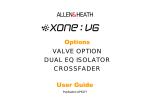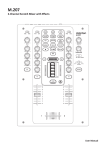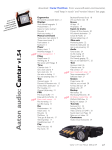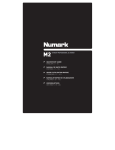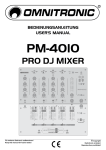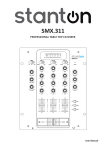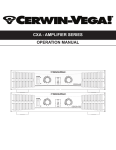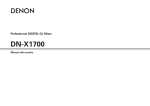Download Snapper L T145H33GBV Lawn Mower User Manual
Transcript
M.203 2-Channel Scratch Mixer User Manual Important Safety Instructions 1. 2. 3. 4. 5. 6. 7. 8. 9. 10. 11. 12. 13. 14. 15. 16. 17. 18. 19. 20. 21. 22. Read Instructions – All the safety and operating instructions should be read before this product is operated. Retain Instructions – The safety and operating instructions should be retained for future reference. Heed Warnings – All warnings on the appliance and in the operating instructions should be adhered to. Follow Instructions – All operating and use instructions should be followed. Water and Moisture – The appliance should not be used near water – for example, near a bathtub, washbowl, kitchen sink, laundry tub, in a wet basement, or near a swimming pool, and the like. Heat – Appliance should be situated away from heat sources such as radiators, heat registers, stoves, or other appliances (including amplifiers) that produce heat. Power Sources – This product should be operated only from the type of power source indicated on the rating label. If you are not sure of the type of power supply to your home, consult your product dealer or local power company. grounding or Polarization – This product may be equipped with a polarized alternation-current line plug (a plug having one blade wider than the other). This plug will fit into the power outlet only one way. This is a safety feature. If you are unable to insert the plug fully into the outlet, try reversing the plug. If the plug should still fail to fit, contact your electrician to replace your obsolete outlet. Do not defeat the safety purpose of the polarized plug. Power-Cord Protection – Power-supply cords should be routed so that they are not likely to be walked on or pinched by items placed upon or against them, paying particular attention to the cord in correspondence of plugs, convenience receptacles, and the point where they exit from the appliance. Cleaning – The appliance should be cleaned only as recommended by the manufacturer. Clean by wiping with a cloth slightly damp with water. Avoid getting water inside the appliance. Non-use Periods – The power cord of the appliance should be unplugged from the outlet when left unused for a long period of time. Object and Liquid Entry – Care should be taken so that objects do not fall and liquids are not spilled into the enclosure through openings. Damage Requiring Service – The appliance should be serviced by qualified service personnel when: A. The power-supply cord or the plug has been damaged; or B. Objects have fallen, or liquid has been spilled into the appliance; or C. The appliance has been exposed to rain; or D. The appliance does not appear to operate normally or exhibits a marked change in performance; or E. The appliance has been dropped, or the enclosure damaged. Servicing – The user should not attempt any service to the appliance beyond that described in the operating instructions. All other servicing should be referred to qualified service personnel. Ventilation – Slots and openings in the cabinet are provided for ventilation and to ensure reliable operation of the product and to protect it from overheating, and these openings must not be blocked or covered. The openings should never be blocked by placing the product on a bed, sofa, rug, or other similar surface. This product should not be placed in a built-in installation such as a bookcase or rack unless proper ventilation is the manufacturer’s instructions have been adhered to. Attachments – do not use attachments not recommended by the product manufacturer as they may cause hazards. Accessories – Do not place this product on an unstable cart, stand, tripod, bracket, or table. The product may fall, causing serious injury to a child or adult, and serious damage to the product. Use only with a cart, stand, tripod, bracket, or table recommended by the manufacturer, or sold with the product. Any mounting of the product should follow the manufacturer’s instructions, and should use a mounting accessory recommended by the manufacturer. Replacement Parts – When replacement parts are required, be sure the service technician has used replacement parts specified by the manufacturer or have the same characteristics as the original part. Unauthorized substitutions may result in fire, electric shock, or other hazards. Safety Check – Upon completion of any service or repairs to this product, ask the service technician to perform safety checks to determine that the product is in proper operating conditions. This product is in compliance with EU WEEE regulations. Disposal of end of life product should not be treated as municipal waste. Please refer to your localregulations for instructions on proper disposal of this product. Carts and Stands – The appliance should be used only with a cart or stand that is recommended by the manufacturer. An appliance and cart combination should be moved with care. Quick stops, excessive force, and uneven surfaces may cause the appliance and cart combination to overturn. The appliance coupler is used as the disconnect device, the disconnect device shall remain readily operable. WARNINg To reduce the risk of electric shock, do not expose this apparatus to rain or moisture. Ensure that the apparatus is not exposed to splashing and that no objects filled with liquids, such as vases, are placed on the apparatus. CAUTION DO NOT OPEN RISK OF ELECTRIC SHOCK CAUTION: To reduce the risk of electric shock, do not remove any cover. No user serviceable parts inside. Refer servicing to qualified personnel only. The lighting flash with arrowhead symbol within the equilateral triangle is intended to alert the user to the presence of un-insulated “dangerous voltage” within the product enclosure that may be significant enough to constitute a risk of electric shock. The exclamation point within the equilateral triangle is intended to alert the user to the presence of important operation and maintance (servicing) instructions in the literature accompanying this appliance. CAUTION To prevent electric shock, do not use this polarized plug with an extension cord, receptacle or other outlet unless the blades can be fully inserted to prevent blade exposure. ii Contents 1. Introduction ................................................................................................................................................................ 1 1.1. Welcome to the M.203! ................................................................................................................................................. 1 1.2. Overview ........................................................................................................................................................................ 1 2. Connecting the M.203 ................................................................................................................................................. 2 3. M.203 Description ....................................................................................................................................................... 3 3.1. Top Panel ........................................................................................................................................................................ 3 3.2. Front Panel ..................................................................................................................................................................... 5 3.3. Rear Panel ...................................................................................................................................................................... 6 4. Using the M.203 .......................................................................................................................................................... 7 4.1. Front Panel Controls ...................................................................................................................................................... 7 4.1.1. Fader Start ........................................................................................................................................................... 7 4.1.2. Selecting and Reversing the Crossfader Curve .................................................................................................... 7 4.1.3. Selecting the Meter Source ................................................................................................................................. 7 5. Troubleshooting .......................................................................................................................................................... 8 Registration Card ................................................................................................................................................................ 9 Stanton Warranty ............................................................................................................................................................. 10 Specifications ................................................................................................................................................................... 11 iii Introduction 1. Introduction 1.1 Welcome to the M.203! Thank you for purchasing the M.203. Before starting, please check that the package your M.203 came in contains: • • • • M.203 unit Power Supply RCA Cable (1) User Manual Now that you have checked that everything was included in the box, let’s talk about this exciting unit. 1.2 Overview The M.203 is a 2-channel performance mixer with build quality and features that make it a leader in this price class. The clean and intuitive design was designed by working DJs with the goal of creating an approachable layout for aspiring DJs and a familiar look and feel that experience pros will appreciate. FEATURES INCLUDE: • Rugged all metal inner-chassis design • Soft Start feature for no noise when powering on/off • Adjustable crossfader curve with FET-isolated "Cut" setting • 2-phono/line(switchable) & 2-line inputs with fader start • 3-Band EQ per channel with complete KILL • Cue Pan fader • Mic input with Tone Control • RCA main & record outputs • 45 mm user replaceable, long-life Alpha crossfader • 2 10-segment LED ladder meters • Cue/Master meter switching • Striking black/gray color scheme Ok, now that we’ve covered the M.203 basics, let’s get started! 1 Connecting the M.203 2. Connecting the M.203 Before starting to connect the M.203, please read the Important Safety Instructions page and the following guidelines: Study this setup diagram (Figure 2.1). Make sure all faders are at "zero,” the Master knob is turned all the way counterclockwise, and all devices are Off. Figure 2.1 First, connect all input sources. Next, connect your microphone and headphones (located in the Front Panel, Figure 3.2). Finally, connect the stereo outputs to the power amplifier(s) and/or audio receivers such as tape decks. Plug your mixer and other devices into AC power. Now, switch everything on in the following order; audio input sources such as turntables or CD players first, then your mixer, and finally any amplifiers. When turning Off, always reverse this operation by turning Off amplifiers, then your mixer, and lastly any input devices. 2 M.203 Description 3. M.203 Description 3.1 Top Panel (Figure 3.1) Figure 3.1 3 M.203 Description Note Since Channels 1 (PH1/LN1) & 2 (PH2/LN2) contain the same controls and functionality; we will only describe them once and duplicate the numbering: 1. Mic Volume (gAIN): Adjusts the volume of the MIC input. 2. Mic Tone: Adjusts the tonal balance of the MIC input, with either a Low Boost/High Cut or High Boost/Low Cut. 3. Fader Start (FDR START): Switches the FADER START ON/OFF. This feature is used to trigger playback on a connected CD Player when the fader is used. 4. Input Selector Switch: Selects the Phono (PH) or Line (LN) input. 5. Channel gain (gAIN): Adjusts the pre-fader volume of the PH or LN input. 6. Channel EQ: Adjusts the HI, MID, and LOW frequency levels of the PH or LN input. 7. Channel Fader: Controls the output level of the selected input (PH or LN). 8. Meter Select Switch: Selects if the Meter displays the pre-channel fader (7) or Master (12) volume. 9. Level Meter: Displays the pre-channel fader (7) or Master (12) volume, depending on what is selected on the Meter Select switch (8) 10. Fader Curve Switch: This switch selects between a LONG or SHARP fade for the crossfader. 11. Crosssfader: Fades between the Channel 1 and Channel 2 signals. 12. Master Level: Controls the overall output level. 13. Headphone Level: Adjusts cue volume. 14. Cue Source (Pre, Post, Master): This switch allows you to select two headphone sources: PRE, POST, or MASTER. On this feature, PRE refers to the Crossfader (11). In PRE position, the signal selected by the CUE PAN. On this feature, PRE refers to the Crossfader (11). In PRE position, the signal selected by the CUE PAN FADER (36) will be monitored (pre-line fader, precrossfader) as a stereo signal in the headphones. In MASTER position, the signal monitored will be pre-master volume (postfaders), meaning the signal will still be present in the headphone even if the Master volume control is turned down. 15. Cue Pan: Fades the headphone output between channels 1 and 2. This allows you to preview a mix, before bringing up Channel Faders or moving the Crossfader. 4 M.203 Description (Front Panel) 3.2 M.203 Description - Front Panel (Figure 3.2) Figure 3.2 1. Headphone Output: Standard 1/4” headphone output connector. 5 M.203 Description (Rear Panel) 3.3 M.203 Description - Rear Panel (Figure 3.3) Figure 3.3 1. Power Switch: Turns the mixer ON or OFF. 2. DC IN: Input connection for the included power supply. While the power is switched OFF, plug the power supply into the mixer first, and then plug it into the outlet. Only use the supplied or official replacement Stanton® power supply. 3. Unbalanced Master output: RCA connectors are typically used to connect to a home stereo, or to another mixer with RCA inputs for practicing or team routines. 4. REC: The record output is not affected by the Master volume control. It can be used to record to a computer, CD, MD, & tape recorder, even while the master volume is turned down. 5. Line Inputs: Unbalanced RCA jacks for connecting stereo audio from line level sources such as CD players, Hi-Fi VCRs, cassette decks, DAT machines, laser discs, tuners, Mini Discs, even synthesizers or other mixing consoles. Plug mono audio sources into both Left and Right inputs using a "Y" cable connector. 6. Line/Phono Inputs: Unbalanced RCA jacks for connecting stereo audio from sources such as Turntables, CD players, Hi-Fi VCRs, cassette decks, DAT machines, laser discs, even synthesizers or other mixing consoles. When connecting a turntable, make sure the switch labeled “Ph/Line” is switched to “Phono”. When connecting a Line/Level source, make sure the switch is turned to “Line” 7. Line/Phono Input Switch: This switch activates the Phono Preamp on the Line/Phono input for use with Turntables. 8. ground connector: To eliminate electrical hum, connect the ground cable from your standard turntable ground post to the M.203 ground terminal. Some turntables (like the Stanton STR8.150) do not require grounding wire. 9. Fader Start: To use this function you need a CD player with the Fader Start feature and its related cable so you can use the Crossfader to start and stop the CD player. The Fader Start switch (Front Panel, Figure 3.1, 3) activates the Fader Start feature. When the Fader Start switch is in the ON position, this function allows the fader to activate or return to the preset Cue Point on your compatible CD Player. 10. Microphone Input (Mic): Connect a standard unbalanced (1/4") microphone. 6 Using the M.203 4. Using the M.203 4.1 Top Panel Controls (Figure 4.1) Figure 4.1 4.1.1 Fader Start Fader start enables the Crossfader on the M.203 mixer to start and stop playback on a CD player. To use this function you need a CD player (like Stanton’s C.324) with the Fader Start feature and its related cable. You can use this feature to trigger playback on a deck that might be just out of physical reach or to do a fader based beat juggle between 2 decks. The Fader Start switch activates the Fader Start feature. When the Fader Start switch is in the ON position, this function allows the fader to activate or return to the preset Cue Point on your compatible CD Player. Now, let’s customize the Crossfader curve. 4.1.2 Selecting the Crossfader Curve 1. Use the Crossfader Curve (CF CURVE) knob to select between a MIX or CUT fade for the Crossfader. Use the MIX setting for fading between two sources. Select the CUT setting for scratching or rapid mixing. 4.1.3 Selecting the Meter Source 1. Use the Meter Select switch to select Selects if the Meter displays the pre-channel fader or Master volume. Select the CUE position to listen to the Pre-Fader signal, using the Cue Fader to practice your mix before playing. Select the MASTER position to listen to the sound from the Master Output through your headphones. 7 Troubleshooting 5. Troubleshooting Problem / Symptom Possible Cause / Solution No Sound. Is the power ON? Based on your connections, check that you have properly set the Input Selector Switch. Make sure that the Input Gain, Channel Fader, and Master output are turned up. Make sure the channels are properly assigned to the Crossfader. No Sound-Headphones. First check that the Headphone Level knob is turned up, and then check the Cue Source (Pre, Post, Master) and Cue Pan settings. Mixer sounds noisy. If a microphone is not being used, turn all its related controls down. Microphone doesn’t work. Is the Mic gain turned up? Does the microphone require phantom power? This mixer does not provide microphone phantom power. Sound is distorted-Line Input. Turn down the Input Gain Control. Check EQ settings. Sound is distorted-Phono/Line Input. Make sure that the Phono/Line switch is selecting the proper source input (‘Phono’ for turntables, ‘Line’ for CD players, etc. that the Turn down the Input Gain Control and check EQ settings. The Fader Start feature does not work. Are you using a CD player that includes that feature? Are you properly connecting the Fader Start cable? Is the Fader Start switch set to ON? Check the Crossfader position. I hear noise/hum. Make sure you are using good shielded audio cables. Some less expensive audio cables can be susceptible to hum and interference. Keep your audio cables away from AC power cables and AC transformers. Make sure the mixer is not mounted too close to high power amplifiers or lighting equipment power supplies or ballasts. Make sure your turntables are properly grounded to the back of the mixer if they include a grounding wire. I hear feedback. If you are using a microphone, make sure that you are not too close to the speakers or headphones. If you hear feedback on the Phono Input, then the turntable may be mounted to close to the speakers and/or subwoofer. Also, make sure the turntable base is placed on a surface that does not vibrate or resonate easily when the speakers are turned up loudly. 8 Registration Card Thank you for choosing Stanton! Your satisfaction is extremely important to us. We proudly stand behind the quality of our work and appreciate that you put your trust in us. Registering your product will help us guarantee that you are kept up to date on our latest advances. Warranty Service in the United States: Please contact Stanton Tech Support BEFORE sending your product. In some cases, our Tech Support team can resolve your problem immediately, avoiding down time due to shipping delays. However, if Tech Support determines that a repair is needed; please call us at +1 (954) 949-9600 to obtain a Return Authorization Number (RA#) PRIOR to shipping your product to us. Warranty Service outside the United States: To initiate a warranty repair, please contact the authorized Stanton dealer from whom you purchased your product, and follow the dealer’s return policy. Save your shipping boxes and all packaging materials! For the fastest and safest product return to Stanton, please use the original shipping carton and packaging materials. Stanton cannot be responsible for any damages incurred during the shipping process due to poor or inadequate packing. Please remember to insure your shipment! 9 Stanton Warranty Stanton Warranty Through Stanton's authorized dealers around the World, Stanton, or one of Stanton's authorized distributors outside the U.S., will, without charge, repair or replace, at the sole discretion of the entity responsible for making the repair or providing the replacement, any Stanton merchandise proved defective in material or workmanship for a period of one (1) year following the date of original purchase. Exceptions to this warranty are as noted below: The warranty for mechanical parts which are subject to wear and tear are limited to either the earlier of thirty (30) days following the date of original purchase or for 10,000 cycles for switches. Stanton will warrant all replacement parts and repairs for ninety (90) days from the date of original shipment. Repairs made necessary by reason of misuse, alteration, normal wear, or accident are not covered under this warranty. Returns Authorized Stanton dealers are only authorized to sell and distribute merchandise within a specific country. All goods requiring warranty repair or replacement must be returned (freight prepaid if not hand-delivered) to the authorized Stanton dealer from whom the merchandise was purchased and in the same country where the merchandise was purchased. For purposes of purchases made via the Internet, the merchandise must be returned to the authorized Stanton dealer in the country where the authorized Stanton dealer which sold the merchandise to purchaser is located and not the authorized Stanton dealer in the country where the purchaser is located or the country in which the merchandise was received. Any returns to a non-authorized dealer or to an authorized Stanton dealer not in the same country as the merchandise was intended to be sold or as set forth above will void this warranty. To initiate a warranty repair, you must contact the authorized Stanton dealer from whom you purchased the merchandise, and follow such authorized Stanton dealer's return policy. Stanton assumes no risk and shall be subject to no liability for damages or loss resulting from the specific use or application made of the merchandise. Stanton's liability for any claim, whether based on breach of contract, negligence, infringement of any rights of any party, or product liability, and relating to the merchandise shall not exceed the price received by Stanton from your purchase of such merchandise. In no event will Stanton be liable for any special, incidental or consequential damages (including loss of use, loss of profit and claims of third parties) however caused, whether by the negligence of Stanton or otherwise. To the extent permitted by law and except as otherwise provided above, Stanton disclaims any express or implied warranties of merchantability or fitness for a particular purpose. The above warranty provides you with specific legal rights. You may also have additional rights, which are subject to variation from state to state and country to country. If there is a dispute regarding the warranty of merchandise that does not fall under the warranty conditions stated above, please include a written explanation with the merchandise when returned pursuant to the terms and conditions set forth herein. 10 Specifications Specifications 1. POWER: AC 100 – 240 V, 50/60 Hz, 16 W 2. DIMENSIONS (H x W x D) 108.2 mm x 250 mm x 352.6 mm 10.82 cm x 25 cm x 35.26 cm 3. WEIgHT: 9.25 lbs / 4.2 kg 4. STANDARD TEST CONDITION: Ambient Temperature: 22 +/- 2% Relative Humidity: 65 +/- 5% 5. INPUT/OUTPUT IMPEDANCE & SENSITIVITY: (EQ FLAT, UNITY GAIN (ALL GAIN, LEVEL AT CENTER, FADER MAXIMUM), FX OFF, LOAD=100K ohm) 5-1. Input Impedance and Reference Level: Line: 20K ohm /-10 dBV +/-0.1 dB (316 mV) Phono: 47K ohm /-50 dBV +/-0.1 dB (3.16 mV) Mic: 10K ohm /-50 dBV +/-0.1 dB (3.16 mV) 5-2. Output Impedance and Level: Rec: 2.2K ohm /-10 dBV (316 mV) +/-2 dB Master Unbal: 1K ohm /-10 dBV (316 mV) +/-2 dB Phones (Load=32 ohm) 33 ohm /-10 dBV (316 mV) +/-2 dB 6. FREQUENCY RESPONSE: (EQ FLAT, UNITY GAIN, FX OFF, LOAD=100K ohm) Line: 20 Hz – 20 kHz +/-2 dB Phono: 20 Hz – 20 kHz +2/-3 dB (RIAA) Mic: 20 Hz – 20 kHz +2/-3 dB 7. THD + N: (EQ FLAT, UNITY GAIN, FX OFF, W/20 kHz LPF, LOAD=100K ohm) Line: Less than 0.03% @1 kHz Phono: Less than 0.1% @ 1 kHz (A-WEIGHTED) Mic: Less than 0.1% @ 1 kHz (A-WEIGHTED) 8. MAXIMUM INPUT: (1 kHz, THD=1%, EQ FLAT, UNITY GAIN, FX OFF, LOAD=100K ohm) Line: More than +14 dBV Phono: More than -26 dBV Mic: More than -26 dBV 9. MAXIMUM OUTPUT: (1 kHz, THD=1%, EQ FLAT, MAXIMUM GAIN, FX OFF, LOAD=100K ohm) Master: More than +18 dBV (8.0 V) Rec: More than +13 dBV (4.5 V) Phones More than +4 dBV (1.58 V) LOAD=32 ohm 10. NOISE FLOOR: (EQ FLAT, UNITY GAIN, FX OFF, W/20 kHz LPF, A-WEIGHTED, LOAD=100K ohm) Line, Aux: Less than -86 dBV Phono: Less than -75 dBV Mic: Less than -76 dBV 11. CROSSTALK: (EQ FLAT, UNITY GAIN, FX OFF, W/20 kHz LPF, A-WEIGHTED, MASTER = +14 dBV OUTPUT) L.R Separation: More than 65 dB @ 1 kHz for LINE, and PHONO Between Channels: More than 70 dB @1 kHz for LINE to LINE,MIC More than 70 dB @ 1 kHz for LINE to PHONO 12. EQ: (UNITY GAIN, FX OFF, W/20 kHz LPF, LOAD=100K ohm) Low Mid High 10 +/-2 dB, below -20 dB at 70 Hz 10 +/-2 dB, below -21 dB at 1 kHz 10 +/-2 dB, below -18 dB at 13 kHz 13. CHANNEL BALANCE: Within 3 dB FROM 0 TO -40 dB 14. FADER KILL: (EQ FLAT, UNITY GAIN, FX OFF, W/20 kHz LPF, A-WEIGHTED, MASTER = +14 dBV OUTPUT) Channel Fader: More than 75 dB at 1 kHz Crossfader: More than 75 dB at 1 kHz 15. ACCESSORIES: User Manual 1 pc AC Power Supply 1 pc 11 Copyright © 2010 Stanton Magnetics, Inc. M.203 and STR8.150 are trademarks or registered trademarks of the Stanton Group. All other trademarks are property of their respective owners, who are in no way affiliated with Stanton DJ or SC System products. All information included in the User Manual is subject to change without notice. +1 (954) 949-9600 LITS00052 10/05/2009















